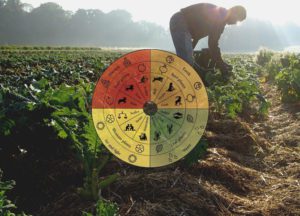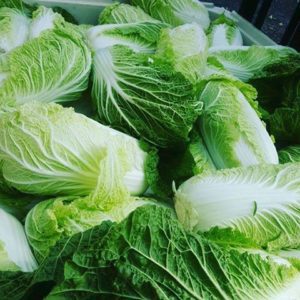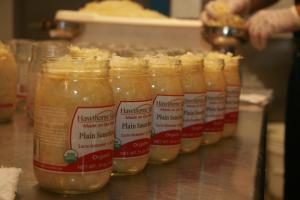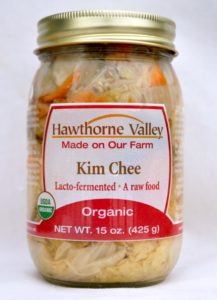
Since 1972, Hawthorne Valley Farm has been producing high-quality, Biodynamic and organic foods while providing farm-based learning experiences for children and adults. Their 900-acre Demeter certified Biodynamic farm includes dairy cows, vegetables, a creamery, an organic bakery, a sauerkraut cellar, and more. Watch this video to gain an appreciation for their farming techniques and community contributions.
Hawthorne Valley Farm’s work revolves around cultivating relationships: with the earth, the surrounding communities and landscape, and with one another. The times are calling for a new form of agriculture – Agriculture 3.0 – that requires a radically enlarged context of sound farming principles, new economic forms and parameters, and renewed recognition of the role of agriculture and agriculturists in our culture and society. Dig deeper into the philosophy behind Hawthorne Valley by reading more about them on their website.
 What is Biodynamics?
What is Biodynamics?
Short Answer:
It is a type of organic agriculture, based on the ideas of the philosopher Rudolf Steiner.
Medium Answer:
Biodynamics can be called “organic plus”. Biodynamics views the farm as a whole, interconnected organism, and tries to take as little input from outside the farm as possible. The animal and vegetable components of the farm complement each other, with the (composted) manure from the animals providing the fertility for the vegetables. Hawthorne Valley Farm also applies homeopathic remedies (called “preparations”) to the fields and compost to improve the vitality of the soil, and tries to take into account astronomical influences, such as moon cycles, on the growth of plants.
Longest Answer (when combined with above):
Biodynamics was created in the early 20th century before chemical use had become common in agriculture. It is based on a series of lectures given by the Austrian philosopher Rudolf Steiner, whose work also led to Waldorf education, and to Anthroposopy, a “spiritual science”. In a series of lectures in 1924, Steiner outlined his ideas on how to actively work with the life-giving forces of nature to help renew the vitality and fertility of farms.
What is Demeter?
Demeter is the certifying agency for Biodynamic farms. It is an international organization with affiliates in many other countries.
Sauerkraut Cellar
At Hawthorne Valley Farm, they have been making delicious lacto-fermented vegetables since 1999. It started with a crock, a bumper crop of cabbage, and a little salt. The results were a hit, and they have been making sauerkraut (and now lots of other products) ever since! These hand-crafted foods are sold in our fermentation fridge, and include: Plain, Caraway, Ruby, Turmeric and Jalapeno (Fire) sauerkrauts; Ginger Carrots, Kim Chee; Hot Pepper Sauce.
Sauerkraut Questions
How long will this keep?
Before opening, Hawthorne Valley Farm lactofermented products should be stored in the refrigerator, just as one would store apple cider or milk. If the jars are kept full and cool, they will usually keep for at least 6 months. After they are opened, if allowed to sit untouched in the refrigerator for over a month or two, depending on how “juicy” the batch is, the top layer may “dry out” and the flavor of that layer of sauerkraut could be compromised. The remedy for this is to remove the top layer, and a little more, to where the sauerkraut is still moist and fragrant.

How do I know if it’s still good?
We don’t advocate eating anything you’re not sure about, however, the pH of our products is low enough so that if there’s a problem with it you will be able to tell. We recommend that if you’ve stored a partially consumed jar of sauerkraut for a long time (see above), and find that you don’t enjoy the remainder, that you replace the jar.
Does it have dairy in it?
There are no dairy products used in any of Hawthorne Valley Farm’s lactofermented sauerkrauts, pickles or juices.
What does “lacto” mean then?
“Lacto” refers to “lactobacillus” bacteria, a family of bacteria that are also present in mother’s milk, and are widely believed to be beneficial to our digestive and immune systems.
What are the health benefits of eating this?
These products, if unheated, contain significant amounts of vitamin C, digestive enzymes, and lactobacillus bacteria. These bacteria are similar to the ones found in “probiotic” supplements. Some good references regarding the benefits of Lactofermentation are Wild Fermentation by Sandor Katz (www.wildfermentation.com) and Nourishing Traditions by Sally Fallon.
 How do I eat this?
How do I eat this?
Generally, these products are good eaten by themselves, or with many foods either high in protein, complex carbohydrates, fats or a combination of the three! Keep reading for a seasonal list of delicious ways to incorporate fermented products into your menus.
Sauerkraut Serving suggestions:
Winter (or any time!):
- Use as a condiment with a nice hot bowl of soup
- Add to freshly made grains, with some avocado or tahini sauce
- Eat with any beef, chicken or fish dish
- Right out of the jar!
Spring (or any time!)
- On spinach salad (add ginger carrots and ruby sauerkraut for a beautiful effect!)
- As a condiment with an omelet
Summer (or any time!)
- Add to a sandwich, burger or hot dog
- On any salad, with avocado and fresh garlic
Fall (or any time!)
- In carrot salad, with ground up nuts and shredded apples
- With ground up sunflower seeds, salt and avocado rolled in a raw kale leaf
